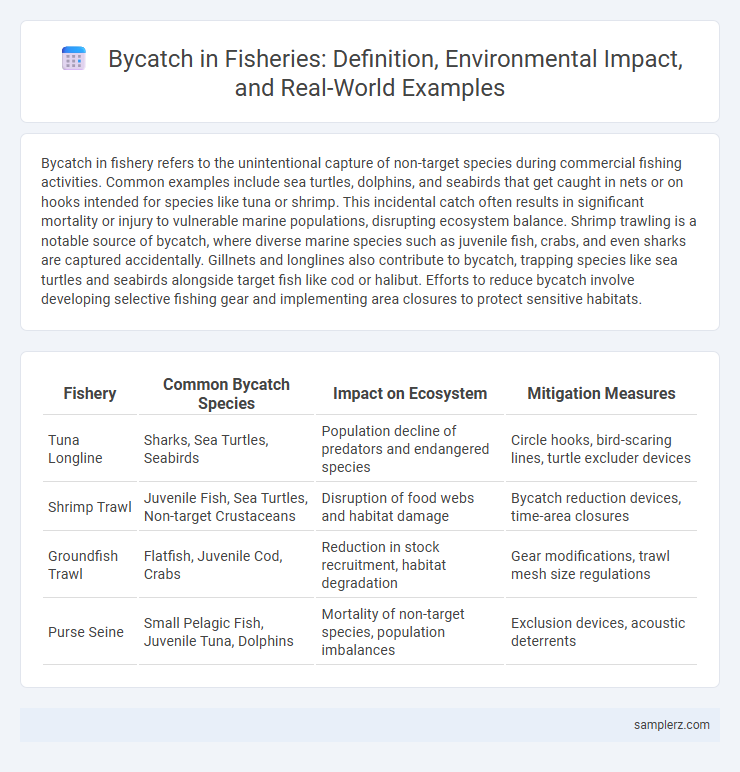Bycatch in fishery refers to the unintentional capture of non-target species during commercial fishing activities. Common examples include sea turtles, dolphins, and seabirds that get caught in nets or on hooks intended for species like tuna or shrimp. This incidental catch often results in significant mortality or injury to vulnerable marine populations, disrupting ecosystem balance. Shrimp trawling is a notable source of bycatch, where diverse marine species such as juvenile fish, crabs, and even sharks are captured accidentally. Gillnets and longlines also contribute to bycatch, trapping species like sea turtles and seabirds alongside target fish like cod or halibut. Efforts to reduce bycatch involve developing selective fishing gear and implementing area closures to protect sensitive habitats.
Table of Comparison
| Fishery | Common Bycatch Species | Impact on Ecosystem | Mitigation Measures |
|---|---|---|---|
| Tuna Longline | Sharks, Sea Turtles, Seabirds | Population decline of predators and endangered species | Circle hooks, bird-scaring lines, turtle excluder devices |
| Shrimp Trawl | Juvenile Fish, Sea Turtles, Non-target Crustaceans | Disruption of food webs and habitat damage | Bycatch reduction devices, time-area closures |
| Groundfish Trawl | Flatfish, Juvenile Cod, Crabs | Reduction in stock recruitment, habitat degradation | Gear modifications, trawl mesh size regulations |
| Purse Seine | Small Pelagic Fish, Juvenile Tuna, Dolphins | Mortality of non-target species, population imbalances | Exclusion devices, acoustic deterrents |
Common Types of Bycatch in Fisheries
Common types of bycatch in fisheries include sea turtles, dolphins, sharks, and seabirds caught unintentionally in fishing nets or on longlines. Bottom trawling often results in the capture of non-target species such as juvenile fish and benthic invertebrates, disrupting marine ecosystems. Bycatch also threatens endangered species like the vaquita and orange roughy, highlighting the urgent need for sustainable fishing practices.
Bycatch of Sea Turtles: Incidental Capture
Bycatch of sea turtles in fisheries occurs when turtles are unintentionally captured in fishing gear such as trawl nets, longlines, and gillnets, leading to injury or mortality. The incidental capture threatens endangered species like the loggerhead, green, and leatherback turtles, disrupting marine biodiversity and ecosystem balance. Implementation of Turtle Excluder Devices (TEDs) has proven effective in reducing turtle bycatch by allowing turtles to escape from trawl nets.
Dolphins and Porpoises Caught in Fishing Gear
Dolphins and porpoises frequently become unintended bycatch in fishing gear such as gillnets and trawl nets, leading to significant mortality rates that threaten their populations. These marine mammals suffer from entanglement and drowning, with species like the common bottlenose dolphin and harbor porpoise particularly affected in coastal fisheries worldwide. Mitigation measures, including acoustic deterrents and modified fishing gear, are critical to reducing bycatch and protecting these vulnerable cetaceans.
Non-Target Fish Species as Bycatch
Non-target fish species, such as juvenile cod and certain types of herring, are frequently caught as bycatch in commercial fisheries targeting more valuable species like tuna or shrimp. This unintended capture disrupts marine ecosystems by reducing biodiversity and affecting population dynamics of these non-target species. Effective bycatch reduction devices and fishing practices are critical to mitigating habitat damage and preserving sustainable fish stocks.
Seabird Mortality Due to Bycatch
Seabird mortality due to bycatch occurs when species like albatrosses and petrels become unintentionally hooked or entangled in fishing gear such as longlines and trawl nets. Studies indicate that bycatch causes the death of thousands of seabirds annually, significantly impacting vulnerable populations and disrupting marine ecosystems. Mitigation measures including bird-scaring lines, weighted hooks, and night setting have shown effectiveness in reducing seabird bycatch rates in commercial fisheries.
Sharks and Rays in Bycatch Statistics
Sharks and rays constitute a significant portion of bycatch in global fisheries, accounting for an estimated 20% of total bycatch volume annually. This unintentional capture often occurs in longline and trawl fisheries targeting tuna and shrimp, causing substantial population declines and disrupting marine ecosystems. Strategies to reduce bycatch include deploying shark-friendly gear modifications and implementing time-area closures in biodiversity hotspots.
Crustaceans and Invertebrates as Bycatch
Bycatch in fisheries frequently includes crustaceans such as crabs and shrimp, which are unintentionally caught alongside target fish species. Invertebrates like sea stars, sea urchins, and various mollusks also constitute significant portions of bycatch, often suffering population declines due to habitat disruption. These non-target captures disrupt marine ecosystems and complicate conservation efforts by affecting biodiversity and ecological balance.
Endangered Species Affected by Bycatch
Sea turtles, including the critically endangered Kemp's ridley and hawksbill species, frequently become unintended victims of bycatch in commercial shrimp trawling operations. These endangered marine animals are entangled in fishing nets designed for target species, leading to significant mortality rates that threaten their already vulnerable populations. Efforts to reduce bycatch, such as turtle excluder devices (TEDs), are crucial to protecting these endangered species and preserving marine biodiversity.
Regional Examples of Bycatch Incidents
In the Gulf of Alaska, sea turtles and seabirds are commonly caught as bycatch during trawl fisheries targeting pollock. Off the coast of West Africa, artisanal fisheries frequently entangle dolphins and manatees in gillnets, posing significant threats to these vulnerable species. In the Mediterranean Sea, swordfish longline fishing has been linked to the accidental capture of loggerhead sea turtles, affecting regional biodiversity and conservation efforts.
Case Studies: Bycatch in Commercial Fisheries
Case studies in commercial fisheries reveal significant bycatch impacts, such as sea turtles caught in shrimp trawl nets along the Gulf of Mexico, causing population declines. In the North Atlantic, Atlantic cod fisheries inadvertently capture juvenile fish and vulnerable marine mammals, disrupting ecosystem balance. These examples highlight the urgent need for selective fishing gear and bycatch reduction technologies to promote sustainable marine biodiversity.

example of bycatch in fishery Infographic
 samplerz.com
samplerz.com